Curing of DER-331 Epoxy Resin with Arylaminocyclotriphosphazenes Based on o-, m-, and p-methylanilines
Abstract
1. Introduction
2. Materials and Methods
3. Results and Discussion
Reaction Conditions
4. Conclusions
Author Contributions
Funding
Institutional Review Board Statement
Informed Consent Statement
Data Availability Statement
Conflicts of Interest
References
- Liu, J.; Lou, X.; Schotman, M.J.; Marín San Román, P.P.; Sijbesma, R.P. Photo-Crosslinked Coumarin-Containing Bis-Urea Amphiphile Hydrogels. Gels 2022, 8, 615. [Google Scholar] [CrossRef]
- Bornosuz, N.V.; Gorbunova, I.Y.; Kireev, V.V.; Onuchin, D.V.; Kerber, M.L.; Petrakova, V.V.; Kryuchkov, I.A.; Nevskiy, R.E.; Sokovishin, A.V.; Khammatova, V.V.; et al. The curing rheokinetics of epoxyphosphazene binders. Materials 2020, 13, 5685. [Google Scholar] [CrossRef]
- Al-Warhi, T.; Abualnaja, M.; Abu Ali, O.A.; Abdel-Razik, H.H.; Albogami, S.M.; Fayad, E. Metallic Porphyrazine Networks: Synthesis, as Well as Thermal and Optical Properties for Accelerating the Oxidation of Thiols to Their Disulfides. Metals 2022, 12, 1523. [Google Scholar] [CrossRef]
- Dong, X.; Sun, J.; Huang, X.; Li, J.; Lv, K.; Zhang, P. Synthesis of a Low-Molecular-Weight Filtrate Reducer and Its Mechanism for Improving High Temperature Resistance of Water-Based Drilling Fluid Gel System. Gels 2022, 8, 619. [Google Scholar] [CrossRef]
- Bornosuz, N.V.; Korotkov, R.F.; Shutov, V.V.; Sirotin, I.S.; Gorbunova, I.Y. Benzoxazine copolymers with mono-and difunctional epoxy active diluents with enhanced tackiness and reduced viscosity. J. Compos. Sci. 2021, 5, 250. [Google Scholar] [CrossRef]
- Costanza, G.; Del Ferraro, A.; Tata, M.E. Experimental Set-Up of the Production Process and Mechanical Characterization of Metal Foams Manufactured by Lost-PLA Technique with Different Cell Morphology. Metals 2022, 12, 1385. [Google Scholar] [CrossRef]
- Mohammed, A.M.; Ariane, M.; Alexiadis, A. Fluid-Structure Interaction in Coronary Stents: A Discrete Multiphysics Approach. ChemEngineering 2021, 5, 60. [Google Scholar] [CrossRef]
- Zawani, M.; Maarof, M.; Tabata, Y.; Motta, A.; Fauzi, M.B. Quercetin-Embedded Gelastin Injectable Hydrogel as Provisional Biotemplate for Future Cutaneous Application: Optimization and In Vitro Evaluation. Gels 2022, 8, 623. [Google Scholar] [CrossRef]
- Zhang, L.; Song, G.; Zhao, Z.; Ma, L.; Xu, H.; Wu, G.; Song, Y.; Liu, Y.; Qiu, L.; Li, X. Structurally Stable, High-Strength Graphene Oxide/Carbon Nanotube/Epoxy Resin Aerogels as Three-Dimensional Skeletal Precursors for Wave-Absorbing Materials. Gels 2022, 8, 618. [Google Scholar] [CrossRef]
- Baş, G.S.; Sancaktar, E. Mechanical behavior of toughened epoxy structural adhesives for impact applications. ChemEngineering 2020, 4, 38. [Google Scholar] [CrossRef]
- Rubino, F.; Tucci, F.; Esperto, V.; Carlone, P. Filling Time Reduction in Liquid Composite Molding Processes. J. Compos. Sci. 2022, 6, 222. [Google Scholar] [CrossRef]
- Naik, N.; Shivamurthy, B.; Thimmappa, B.H.S.; Guo, Z.; Bhat, R. Bio-Based Epoxies: Mechanical Characterization and Their Applicability in the Development of Eco-Friendly Composites. J. Compos. Sci. 2022, 6, 294. [Google Scholar] [CrossRef]
- Samardžija, M.; Alar, V.; Špada, V.; Stojanović, I. Corrosion Behaviour of an Epoxy Resin Reinforced with Aluminium Nanoparticles. Coatings 2022, 12, 1500. [Google Scholar] [CrossRef]
- Liu, Y.; Tang, Z.; Zhu, J. Synergistic flame-retardant effect of aluminum hydroxide and ammonium polyphosphate on epoxy resin. J. Appl. Polym. Sci. 2022, 139, e53168. [Google Scholar] [CrossRef]
- Lukina, Y.S.; Mishchenko, B.P.; Zaytsev, V.V.; Vasilev, M.G.; Selezneva, I.I. Osteoplastic Material Based on a Bone Matrix Resistant to Osteoclastic Resorption under Conditions of a Pronounced Regenerative Process as a Carrier for rhBMP. Inorg. Mater. Appl. Res. 2022, 13, 952–960. [Google Scholar] [CrossRef]
- Fedoseev, M.S.; Derzhavinskaya, L.F.; Scherban, R.V. Thermomechanical and Adhesion Properties of Polymers and Composites as Affected by Nature of Epoxy Isocyanate Binders. Inorg. Mater. Appl. Res. 2021, 12, 1104–1111. [Google Scholar] [CrossRef]
- Zarybnicka, L.; Machotova, J.; Kopecka, R.; Sevcik, R.; Hudakova, M.; Pokorny, J.; Sal, J. Effect of Cyclotriphosphazene-Based Curing Agents on the Flame Resistance of Epoxy Resins. Polymers 2020, 13, 8. [Google Scholar] [CrossRef]
- Bornosuz, N.V.; Korotkov, R.F.; Kolenchenko, A.A.; Shapagin, A.V.; Orlov, A.V.; Gorbunova, I.Y.; Kireev, V.V.; Sirotin, I.S. The Influence of Substituents in Phosphazene Catalyst-Flame Retardant on the Thermochemistry of Benzoxazine Curing. Polymers 2021, 13, 3111. [Google Scholar] [CrossRef]
- Yang, S.; Zhang, Q.; Hu, Y. Synthesis of a novel flame retardant containing phosphorus, nitrogen and boron and its application in flame-retardant epoxy resin. Polym. Degrad. Stab. 2016, 133, 358–366. [Google Scholar] [CrossRef]
- Allcock, H.R.; Morozowich, N.L. Bioerodible polyphosphazenes and their medical potential. Polym. Chem. 2012, 3, 578–590. [Google Scholar] [CrossRef]
- Ganapathiappan, S.; Krishnamurthy, S.S. Studies of phosphazenes. Part 30. Reactions of hexachlorocyclotriphosphazene with aromatic primary amines: Interplay of geminal and non-geminal modes of chlorine replacement. J. Chem. Soc. Dalton Trans. 1987, 3, 579–584. [Google Scholar] [CrossRef]
- Chistyakov, E.M.; Terekhov, I.V.; Shapagin, A.V.; Filatov, S.N.; Chuev, V.P. Curing of Epoxy Resin DER-331 by Hexakis (4-acetamidophenoxy) cyclotriphosphazene and Properties of the Prepared Composition. Polymers 2019, 11, 1191. [Google Scholar] [CrossRef] [PubMed]
- Ballesteros, B.; Santos, L. A reinvestigation of the molecular structures, vibrations and rotation of methyl group in o-methylaniline in S0 and S1 states studied by laser induced fluorescence spectroscopy and ab initio calculations. Spectrochim. Acta Part A Mol. Biomol. Spectrosc. 2002, 58, 1069–1081. [Google Scholar] [CrossRef] [PubMed]
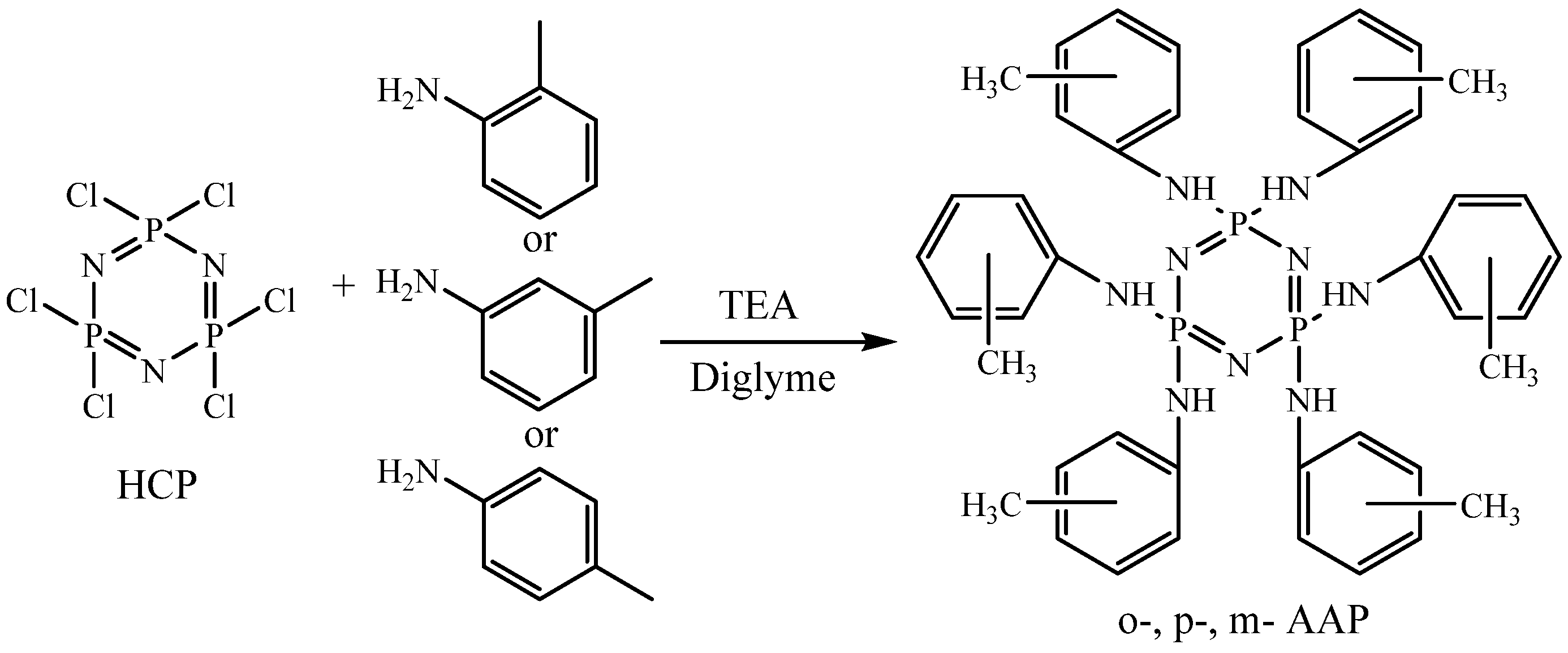
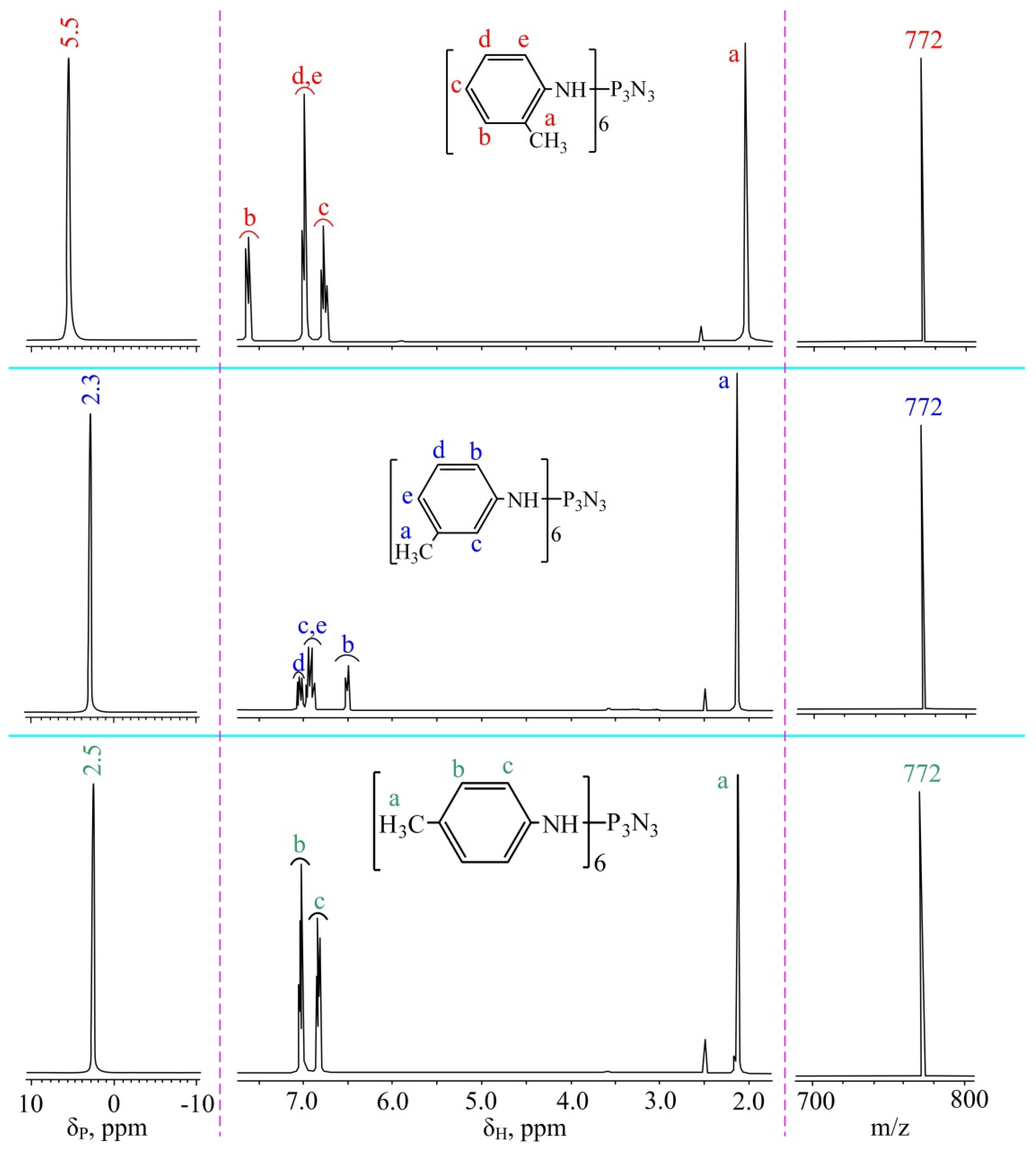
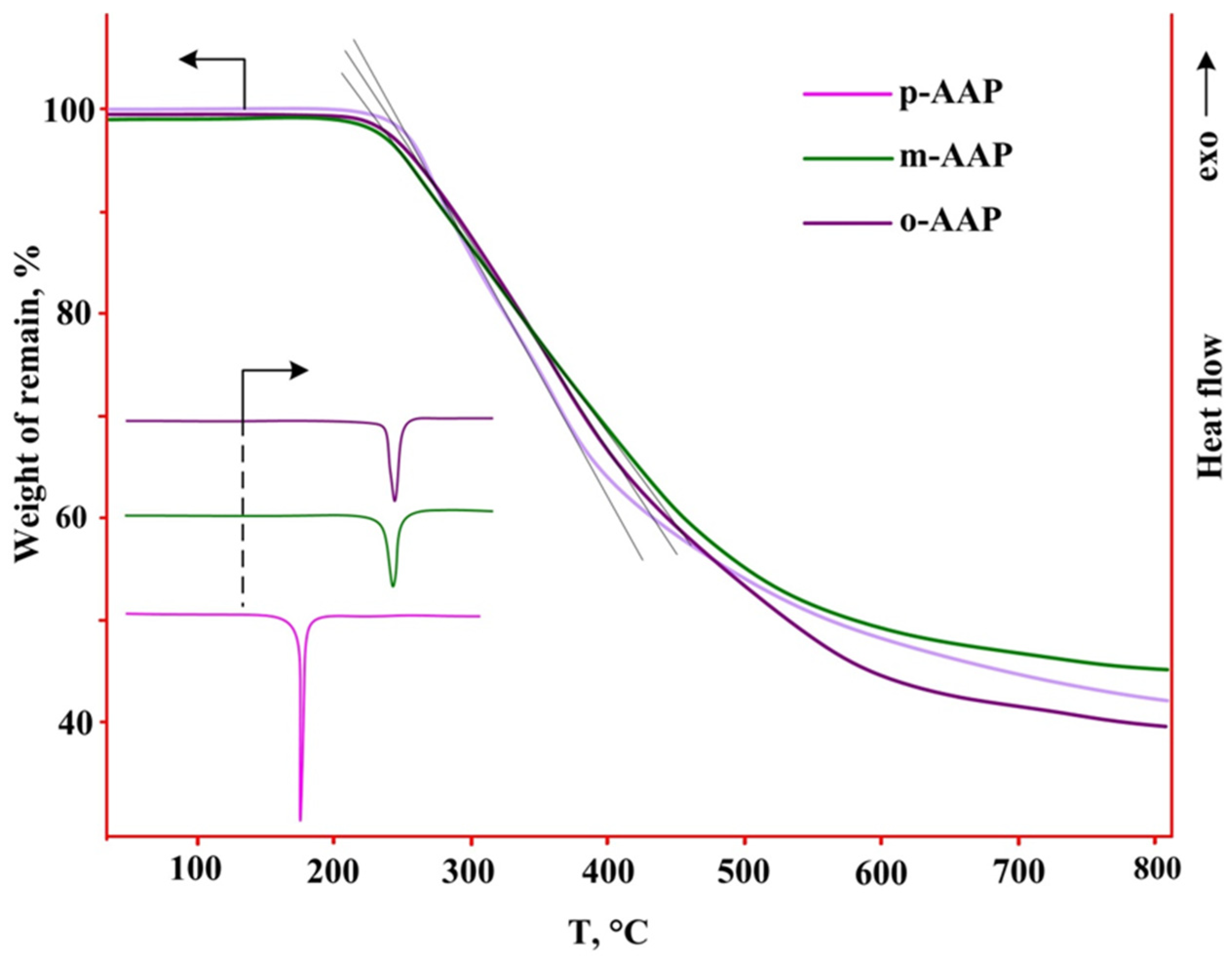

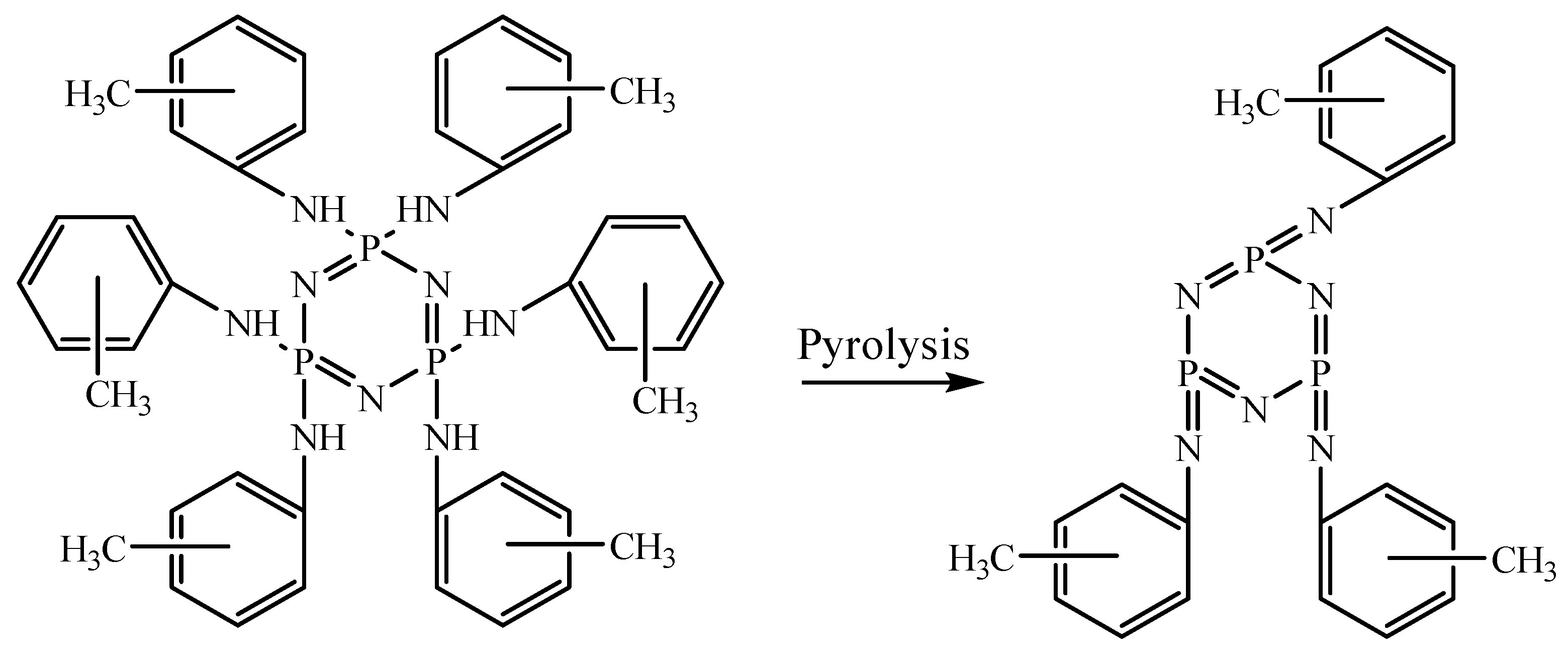


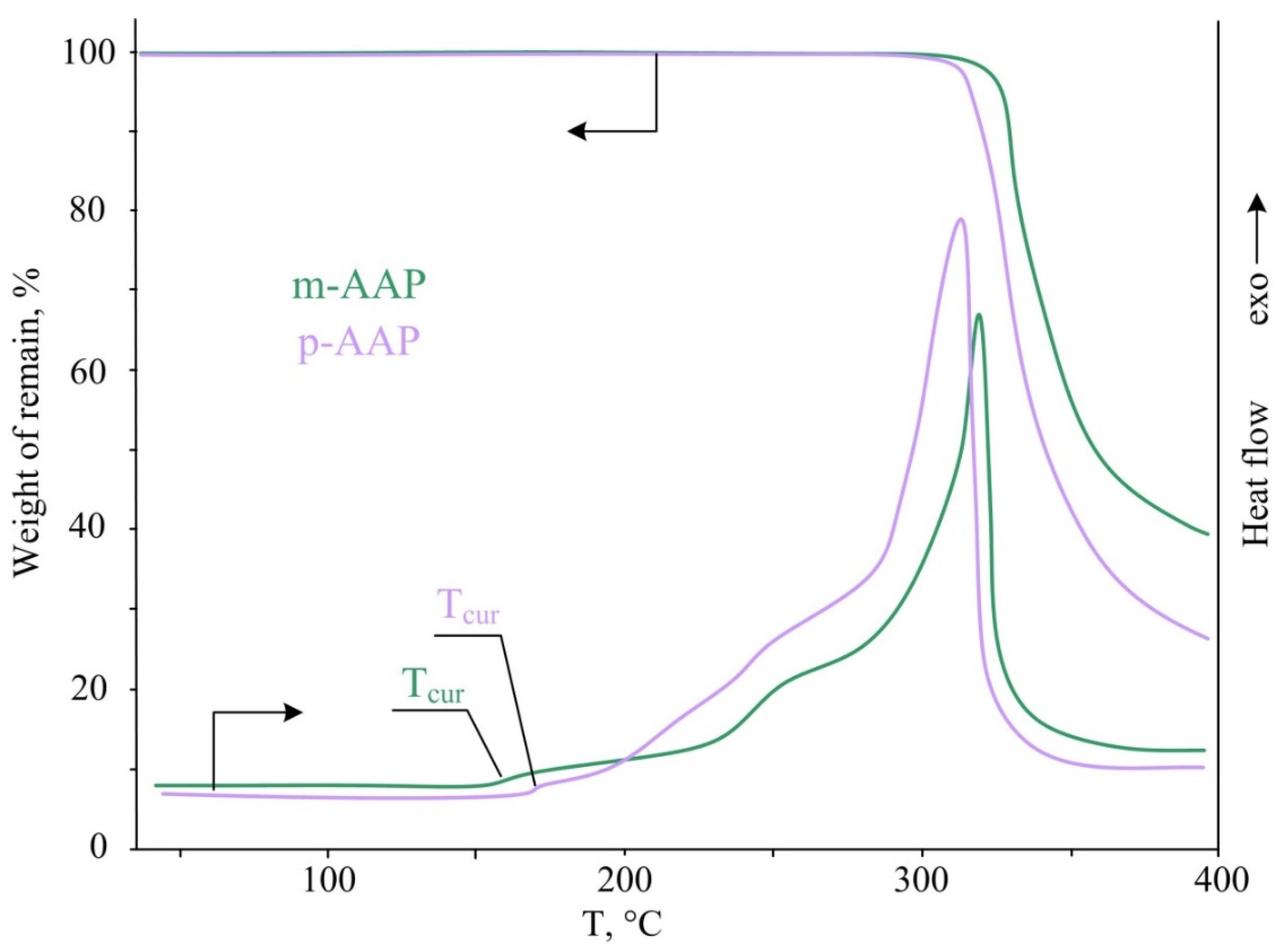
| Curing Agent | Temperature, °C | Mass Loss, % |
|---|---|---|
| M-AAP | 5 | 1.77 |
| 10 | 11.65 | |
| 15 | 97.07 | |
| P-AAP | 5 | 4.48 |
| 10 | 43.93 | |
| 15 | 90.36 | |
| O-AAP | 5 | 0 |
| 10 | 2.76 | |
| 15 | 2.94 |
Publisher’s Note: MDPI stays neutral with regard to jurisdictional claims in published maps and institutional affiliations. |
© 2022 by the authors. Licensee MDPI, Basel, Switzerland. This article is an open access article distributed under the terms and conditions of the Creative Commons Attribution (CC BY) license (https://creativecommons.org/licenses/by/4.0/).
Share and Cite
Rybyan, A.A.; Bilichenko, J.V.; Kireev, V.V.; Kolenchenko, A.A.; Chistyakov, E.M. Curing of DER-331 Epoxy Resin with Arylaminocyclotriphosphazenes Based on o-, m-, and p-methylanilines. Polymers 2022, 14, 5334. https://doi.org/10.3390/polym14245334
Rybyan AA, Bilichenko JV, Kireev VV, Kolenchenko AA, Chistyakov EM. Curing of DER-331 Epoxy Resin with Arylaminocyclotriphosphazenes Based on o-, m-, and p-methylanilines. Polymers. 2022; 14(24):5334. https://doi.org/10.3390/polym14245334
Chicago/Turabian StyleRybyan, Artem A., Julia V. Bilichenko, Vyacheslav V. Kireev, Alexander A. Kolenchenko, and Evgeniy M. Chistyakov. 2022. "Curing of DER-331 Epoxy Resin with Arylaminocyclotriphosphazenes Based on o-, m-, and p-methylanilines" Polymers 14, no. 24: 5334. https://doi.org/10.3390/polym14245334
APA StyleRybyan, A. A., Bilichenko, J. V., Kireev, V. V., Kolenchenko, A. A., & Chistyakov, E. M. (2022). Curing of DER-331 Epoxy Resin with Arylaminocyclotriphosphazenes Based on o-, m-, and p-methylanilines. Polymers, 14(24), 5334. https://doi.org/10.3390/polym14245334







